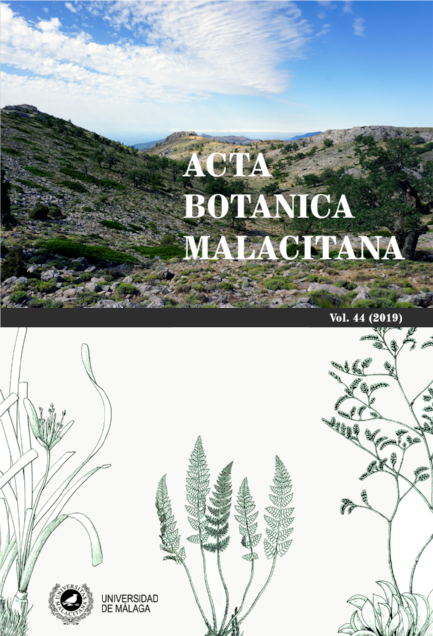Nuevas adiciones a la flora del Perú, VIII
DOI:
https://doi.org/10.24310/abm.v44i0.6431Abstract
New additions to the flora of Peru, VIII
Palabras clave: Biogeografía, flora, páramo, Perú.
Key words: Biogeography, flora, paramo, Peru.
Downloads
Metrics
References
Beltrán, H. (2016). Sinopsis del género Xenophyllum (Asteraceae: Senecioneae) del Perú. Arnaldoa, 23(1), 351-362.
Böhnert, T. & Weigend, M. (2016). Three new species records of Symplocos (Symplocaceae) from northern Peru. Revista peruana de biología, 23(3), 339-342.
doi: http://dx.doi.org/10.15381/rpb.v23i3.12873
Calviño, C.I., Fernández, M. & Martínez, S.G. (2016). Las especies de Azorella (Azorelloideae, Apiaceae) con distribución extra-argentina. Darwiniana, 4(1), 57-82.
http://dx.doi.org/10.14522/darwiniana.v4i1.681
Eriksen, B. (1989a). Notes on generic and infrageneric delimitation in the Valerianaceae. Nordic Journal of Botany, 9, 179-187. doi: https://doi.org/10.1111/j.1756-1051.1989.tb02113.x
Eriksen, B. (1989b). Valerianaceae. In G. Harling & L. Andersson (Eds.), Flora of Ecuador No. 34 (pp. 3-60). Göteborg-Stockholm: University of Göteborg-Riksmuseum.
Funk, V.A. (1997). Xenophyllum, a New Andean Genus Extracted from Werneria s.l. (Compositae: Senecioneae). Novon, 7, 235-241.
Galán de Mera, A., Méndez, E., Linares Perea, E., Campos de la Cruz, J. & Vicente Orellana, J.A. (2014). Las comunidades vegetales relacionadas con los procesos criogénicos en los Andes peruanos. Phytocoenologia, 44(1-2), 121-161. doi: 10.1127/0340-269X/2014/0044-0576
Galán de Mera, A., Linares Perea, E. & Montoya Quino, J. (2018). Mapa de vegetación de Cajamarca. Potencialidad de la vegetación para el uso de plantas medicinales. Cajamarca, PE: UPAGU-Municipalidad Provincial de Cajamarca-Yanacocha.
Galán de Mera, A., Sánchez Vega, I., Montoya Quino, J., Linares Perea, E., Campos de la Cruz, J., Vicente Orellana, J.A. (2015). La vegetación del norte del Perú: De los bosques a la jalca en Cajamarca. Acta Botanica Malacitana, 40, 157-190.
doi: http://dx.doi.org/10.24310/abm.v40i0.2505
Graebner, P. (1906a). Die Gattungen der natürlichen Familie der Valerianaceae. Botanische Jahrbücher fur Systematik, Pflanzengeschichte und Pflanzengeographie, 37, 439-480.
Hensold, N. (1999). Las angiospermas del Departamento de Cajamarca, Perú. Arnaldoa, 6, 141-184.
Graebner, P. (1906b). Valerianaceae andinae. Botanische Jahrbücher fur Systematik, Pflanzengeschichte und Pflanzengeographie, 37, 436-451.
Kahn, F., Millán, B., Cano, A., La Torre, M.I., Baldeón, S., Beltrán, H., Trinidad, H., Castillo, S. & Machahua, M. (2016). Contribución a la flora altoandina del distrito de Oyón, región Lima, Perú. Revista peruana de biología, 23(1), 67-72.
doi: http://dx.doi.org/10.15381/rpb.v23i1.11836
Killip, E.P. (1937). Valerianaceae L. Valerian Family. In J.F. Macbride (Ed.), Flora of Peru Vol. 13(2) (pp. 287-321). Chicago, IL: Field Museum of Natural History.
Lauer, W., Rafiqpoor, M.D. & Theisen, I. (2001). Physiographie, Vegetation und Syntaxonomie der Flora des Páramo de Papallacta (Ostkordillere Ecuador). Stuttgart: Franz Steiner.
León, B. (2006). Valerianaceae endémicas del Perú. Revista peruana de biología, 13(2), 663-668. doi: http://dx.doi.org/10.15381/rpb.v13i2.1929
Linares Perea, E., Campos de la Cruz, J., Nauray Huari, W., Vicente Orellana, J.A. & Galán de Mera, A. (2010). Nuevas adiciones a la flora del Perú, V. Arnaldoa, 17(1), 99-112.
Luteyn, J.L. (1999). Páramos. A checklist of plant diversity, geographical distribution, and botanical literature. New York: The New York Botanical Garden.
Mathias, M.E. & Constance, L. (1976). Umbelliferae. In G. Harling & B. Sparre (Eds.), Flora of Ecuador No. 5 (pp. 1-72). Stockholm: Swedish Natural Science Research Council.
Montoya Quino, J., Torres Marquina, I., Linares Perea, E., Rodríguez Zegarra, C.C. & Galán de Mera, A. (2017a). Nuevas adiciones a la flora del Perú, VII. Acta Botanica Malacitana, 42(2), 339-342. doi: http://dx.doi.org/10.24310/abm.v42i2.2320
Montoya Quino, J., Linares Perea, E., Torres Marquina, I., Vicente Orellana, J.A. & Galán de Mera, A. (2017b). Ageratina neblinensis (Asteraceae, Eupatorieae), una nueva especie para el norte del Perú. Gayana Botánica, 74(2), 288-292. doi: http://dx.doi.org/10.4067/S0717-66432017000200288
QGIS Development Team (2018). QGIS Geographic Information System. Open Source Geospatial Foundation Project. Beaverton, OR: OSGeo (https://www.qgis.org/).
Rangel, J.O. (2018). Las plantas con flores de la región biogeográfica del Páramo (desde Costa Rica hasta Bolivia). In J.O. Rangel (Ed.), Colombia Diversidad Biótica XVI (pp. 1-82). Bogotá: Universidad Nacional de Colombia.
Reynel, C., Pennington, R.T. & Särkinen, T. (2013). Cómo se formó la diversidad ecológica del Perú. Edinburgh: Royal Botanic Garden.
Seminario-Cunya, J.F., Rumay-Sánchez, L.D. & Seminario-Cunya, A. (2016). Biología de Valeriana pilosa R. &. P. (Valerianaceae): una especie en peligro de extinción de las altas montañas de Perú. Boletín Latinoamericano y del Caribe de Plantas Medicinales y Aromáticas,15(5), 337-351.
Weigend, M. (2004). Additional observations on the biogeography of the Amotape-Huancabamba zone in Northern Peru: Defining the South-Eastern limits. Revista peruana de biología, 11(2), 127–134.
Downloads
Published
How to Cite
Issue
Section
License
All information related to the licensing of published works in Acta Botanica Malacitana and copyright can be found in our Editorial Policy.







1.png)
